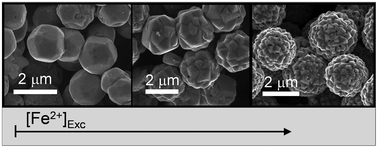Control of surface morphology and internal structure in magnetite microparticles: from smooth single crystals to rough polycrystals†
Abstract

* Corresponding authors
a
Biocolloid and Fluid Physics Group, Applied Physics Department, Faculty of Science, University of Granada, E-18071 Granada, Spain
E-mail:
fvereda@ugr.es
Fax: +34 958243214
Tel: +34 958240025
b Materials Science Institute of Madrid, CSIC, Sor Juana Inés de la Cruz 3, 28049 Cantoblanco, Madrid, Spain
c International Iberian Nanotechnology Laboratory, Braga 4715, Portugal
d CACTI, Vigo University, E-36310 Vigo, Spain

 Please wait while we load your content...
Something went wrong. Try again?
Please wait while we load your content...
Something went wrong. Try again?
F. Vereda, M. D. P. Morales, B. Rodríguez-González, J. D. Vicente and R. Hidalgo-Alvarez, CrystEngComm, 2013, 15, 5236 DOI: 10.1039/C3CE40424B
To request permission to reproduce material from this article, please go to the Copyright Clearance Center request page.
If you are an author contributing to an RSC publication, you do not need to request permission provided correct acknowledgement is given.
If you are the author of this article, you do not need to request permission to reproduce figures and diagrams provided correct acknowledgement is given. If you want to reproduce the whole article in a third-party publication (excluding your thesis/dissertation for which permission is not required) please go to the Copyright Clearance Center request page.
Read more about how to correctly acknowledge RSC content.
 Fetching data from CrossRef.
Fetching data from CrossRef.
This may take some time to load.
Loading related content
